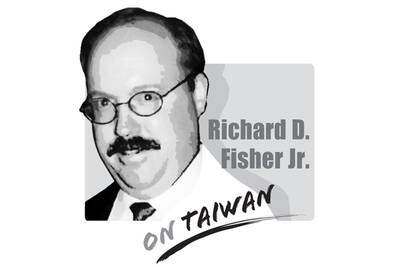Taiwan’s real wages are calculated by dividing the nominal wage found by the Directorate-General of Budget, Accounting and Statistics by the consumer price index for the same year.
Real wages have been adjusted for price fluctuations and are a tangible reflection of how much money people have to spend.
Real wages have two components: regular income — monthly wages, performance bonuses and subsidies — and irregular income — which mostly comes from year-end bonuses paid before the Lunar New Year in January or February.
Salaries earned in the first two months of the year are clearly higher than during the rest of the year.
Irregular income refers to various bonuses other than the year-end bonus, such as bonuses for the three major holidays and employee bonuses, which are not paid by month. Therefore, wage discussions should never be limited to regular income alone.
Looking at real monthly wage data, the years from 1991 to 2017 can be divided into four different periods: 1991 to 1999 when Lee Teng-hui (李登輝) was president, the eight years of Chen Shui-bian’s (陳水扁) presidency from 2000 to 2007, Ma Ying-jeou’s (馬英九) presidency between 2008 and 2015, and the first two years of Tsai Ing-wen’s (蔡英文) presidency.
The crucial demarcation line for these four periods is an average real monthly wage of NT$46,000 (US$1,537).
During Lee’s presidency, average real monthly wages increased from NT$39,000 to NT$46,000, and this number increased by another NT$1,000 during Chen’s presidency.
However, shortly after Ma assumed office, the number quickly dropped to about NT$45,000, with the only exception being 2015 when it bounced back to more than NT$46,000.
The numbers during the other seven years of Ma’s presidency are all below the NT$46,000 standard set during Lee’s presidency, and there were even four years when the average real monthly wages dropped below NT$45,000.
During Tsai’s presidency, average real wages increased to NT$46,594 in 2016 and NT$47,271 last year, a record high.
Some might say that Ma’s presidency coincided with the global financial crisis, but Lee and Chen also encountered a lot of economic shocks: the Gulf War in 1991, the overnight devaluation of the yuan in 1994, the Asian financial crisis in 1997, the domestic financial crisis the following year, the bursting of the dot-com bubble in 2000, the global outbreak of SARS in 2003, and the domestic consumer credit and debt crisis in 2005.
Major events with a heavy impact on the economy presented themselves throughout these years.
Tsai is facing domestic economic problems: pension reform and a fiscal deficit impeding government investment, and shrinking private sector investment, which was supported almost solely by Taiwan Semiconductor Manufacturing Co over the past three years.
To make matters worse, long-term capital outflows have exceeded NT$10 trillion, highlighting the severity of the situation, as the nation’s GDP is about NT$17 trillion.
Under these circumstances, it is no easy task for the government to restore wages and rebuild forward momentum to the levels achieved during the Lee and Chen presidencies.
Instead of repeatedly using misleading ideas to beat down national confidence, the public should acknowledge the government’s efforts during the past two years.
Huang Ci-ru is an assistant professor.
Translated by Chang Ho-ming
US President Donald Trump created some consternation in Taiwan last week when he told a news conference that a successful trade deal with China would help with “unification.” Although the People’s Republic of China has never ruled Taiwan, Trump’s language struck a raw nerve in Taiwan given his open siding with Russian President Vladimir Putin’s aggression seeking to “reunify” Ukraine and Russia. On earlier occasions, Trump has criticized Taiwan for “stealing” the US’ chip industry and for relying too much on the US for defense, ominously presaging a weakening of US support for Taiwan. However, further examination of Trump’s remarks in

As the Chinese Communist Party (CCP) and its People’s Liberation Army (PLA) reach the point of confidence that they can start and win a war to destroy the democratic culture on Taiwan, any future decision to do so may likely be directly affected by the CCP’s ability to promote wars on the Korean Peninsula, in Europe, or, as most recently, on the Indian subcontinent. It stands to reason that the Trump Administration’s success early on May 10 to convince India and Pakistan to deescalate their four-day conventional military conflict, assessed to be close to a nuclear weapons exchange, also served to
China on May 23, 1951, imposed the so-called “17-Point Agreement” to formally annex Tibet. In March, China in its 18th White Paper misleadingly said it laid “firm foundations for the region’s human rights cause.” The agreement is invalid in international law, because it was signed under threat. Ngapo Ngawang Jigme, head of the Tibetan delegation sent to China for peace negotiations, was not authorized to sign the agreement on behalf of the Tibetan government and the delegation was made to sign it under duress. After seven decades, Tibet remains intact and there is global outpouring of sympathy for Tibetans. This realization
After India’s punitive precision strikes targeting what New Delhi called nine terrorist sites inside Pakistan, reactions poured in from governments around the world. The Ministry of Foreign Affairs (MOFA) issued a statement on May 10, opposing terrorism and expressing concern about the growing tensions between India and Pakistan. The statement noticeably expressed support for the Indian government’s right to maintain its national security and act against terrorists. The ministry said that it “works closely with democratic partners worldwide in staunch opposition to international terrorism” and expressed “firm support for all legitimate and necessary actions taken by the government of India